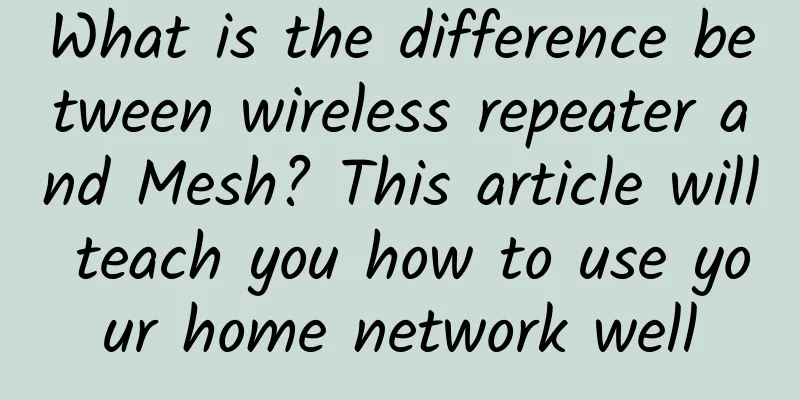What is the difference between wireless repeater and Mesh? This article will teach you how to use your home network well

|
At present, people's lives are becoming richer than ever before. Whether it is 4K movie watching, VR/AR games, remote office, or high-definition live broadcast, there are higher requirements for home networks. As more and more people live in improved housing or the house structure becomes more complicated, the quality of wireless signals has gradually become a major obstacle to user experience. For this reason, some people have tried wireless relays, hoping to make the signal "relay" cover a wider range, while some people directly buy Mesh routers. So which of these two solutions is better? Considering that the country has strict regulations on radiation power, the signal coverage of wireless routers will always be limited. In indoor rooms with spacious apartments, the signal performance is acceptable, but in large apartments with complex apartment structures, flats, villas, etc., the wireless signal of a wireless router is difficult to meet user needs. At this time, many people will choose wireless repeaters. A wireless repeater is an intermediate device that connects a wireless router and a user's device. After receiving the signal from the wireless router, it forwards it to the user's device, allowing the user's device to receive a stable and strong wireless signal. Users need to deploy a wireless repeater on a socket at a relatively edge of the wireless router signal coverage, and then simply set it up so that the wireless repeater can extend the wireless network to the room that needs coverage. Usually, a wireless repeater is deployed at the edge of the wireless router signal coverage, receiving the original routing signal and then expanding outward. However, wireless repeaters also have disadvantages. While the signal strength is improved, the speed of the wireless network after the relay will decrease to a certain extent, generally reducing the wireless transmission rate by half, which will compromise the WiFi experience. It takes a little price to fully cover the places that the original wireless network cannot cover. At the same time, when multiple devices are needed for relaying, the wireless repeater can only bridge to the previous wireless repeater and cannot relay the main router, so the wireless speed will be halved layer by layer. In contrast, Mesh networking allows wireless routers to relay wireless signals to each other, forming a cellular network. For example, traditional wireless relay technology can only transmit from A to B, and then from B to C, and C and A cannot communicate. Of course, Mesh, or wireless mesh network, is not a new technology. As early as 2016, many companies launched new wireless routers using mesh network technology. Wireless mesh network allows wireless routers to relay wireless signals to each other. Mesh network will form a network like a "bee hive" between multiple devices. As long as the user is within the signal range of the main router and powers on the access point, the home WiFi coverage can be easily expanded. According to the experience of many users, more people now still choose Mesh networking as the first choice for large or complex apartments. In terms of network implementation, it is usually started from the renovation. In the water and electricity renovation stage of the renovation, network wiring is very important. The general practice is to set up a weak current box at the entrance of the home network, and then lead the network cable from the weak current box to each room, leaving a network port for each room. In this way, it is very convenient to access the Internet through a computer or an external wireless router. In the weak power box, deploy a router and PoE switch, and then deploy a panel AP at the network cable in each room. For routers and switches, it is best to choose products with Gigabit ports, which can well support broadband above 100M, and the intranet transmission can also be faster. It can be seen that Mesh's advantages such as wide coverage, good signal, and no speed reduction have become the choice of more and more people. |
<<: How to Choose the Right Switch for Your Network?
>>: Understand TCP Packet Unpacking in One Minute
Recommend
A complete analysis of the IoT strategies of Huawei, Alibaba and China Unicom
Have you paid attention to the wave of "bomb...
10 ways to deal with data center outages
While data centers are designed to not fail in th...
Hostodo: $34.99/year KVM-2.5GB/25G NVMe/8TB/3 data centers
Hostodo released two special packages in Septembe...
How to connect multiple Ethernet switches?
Ethernet is not a new technology as it has been u...
SoftShellWeb: Taiwan (Taipei) VPS starts at $49 per year, Netherlands VPS starts at $24 per year
SoftShellWeb is a foreign hosting company establi...
The world's first quantum call! The West: The future belongs to China, but technology should be shared
Recently, with the rapid development of China'...
LOCVPS New Year Promotion: Netherlands VPS 40% off, starting from 22 yuan, Singapore VPS/Russia VPS/Hong Kong VPS 30% off
LOCVPS (Global Cloud) is a long-established Chine...
How IPv6 works in the Internet
[[342618]] This article is reprinted from the WeC...
The three major telecom operators earned 387 million yuan a day in 2020
On March 25, China Mobile released its 2020 perfo...
In 2023, 5G and IoT roaming traffic will surge
According to data from international communicatio...
Farewell to the NYSE! The NYSE maintains the delisting decision of the three major operators
[[398109]] On May 7, the three major operators is...
DPtech assists the Road Network Center of the Ministry of Transport to provide security support for the comprehensive establishment of a ministerial-level monitoring system for highway video networking
Recently, Deepin Technology won the bid for the h...
Five myths about instant messaging that every entrepreneur needs to know
Nowadays, enterprise-level instant messaging tool...
Three approaches to Bluetooth low energy development
Ask any IoT vendor what makes their product excit...
How much do you know about Zigbee wireless connection?
Zigbee has a wide range of applications and can o...









